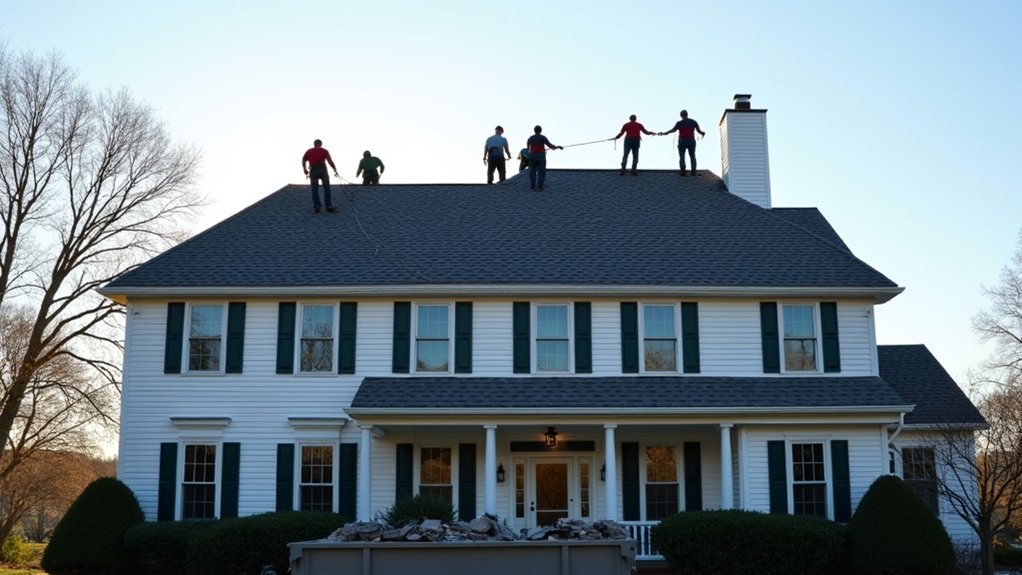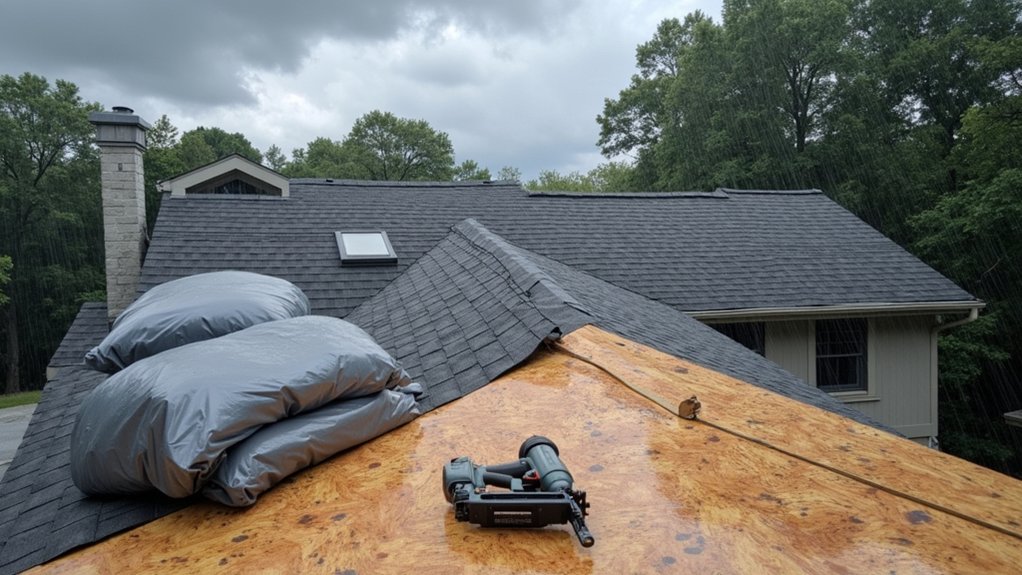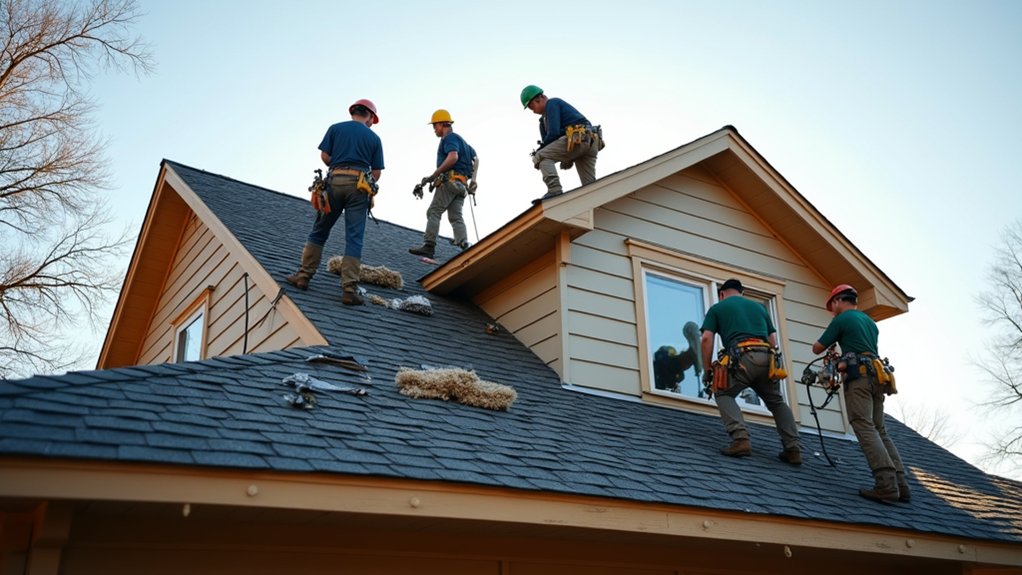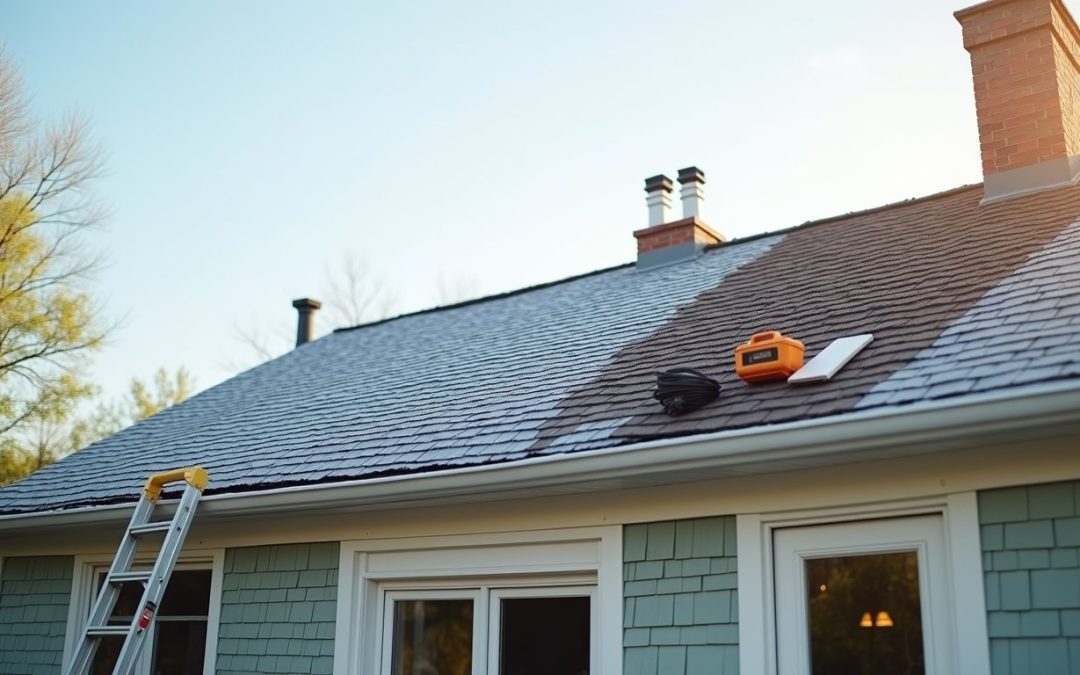Your roof replacement will typically take 1-3 days for standard residential homes, with most 1,500-square-foot projects completed within 48 hours. The timeline depends on several key factors, including your roof’s size, pitch, and complexity, plus the type of materials you’ve chosen. Weather conditions, crew size, and existing damage can also impact the schedule. Understanding these variables will help you better plan for your specific roofing project.
Typical Timeline for Residential Roof Replacements

While several factors influence the duration of a roof replacement, most residential projects take between 1-3 days to complete when performed by an experienced roofing crew.
Your timeline typically begins with a roof inspection process, where contractors assess the scope of work and identify potential challenges. Once you’ve selected a contractor, you’ll need to align with their work schedule, which can affect your project’s start date. A standard 2,000-square-foot roof replacement usually follows this sequence: Day 1 involves tear-off of old materials and preparation of the deck. Day 2 focuses on installing new underlayment, flashing, and shingles. If needed, Day 3 allows for completion of complex areas and final cleanup. Weather conditions, material availability, and structural repairs can extend this timeline.
Key Factors That Impact Project Duration
Several critical factors determine how quickly your roof replacement project will reach completion. During the initial roof condition assessment, contractors evaluate essential elements like existing damage, structural integrity, and the number of shingle layers that need removal. Your roof’s size, pitch, and architectural complexity tremendously influence the timeline, as steeper or more intricate designs require additional safety measures and labor.
Weather conditions play a necessary role in project timeline planning, as precipitation or extreme temperatures can cause delays. The availability of materials, crew size, and permit processing times also impact completion. You’ll need to factor in additional time if your project requires specialized materials or if contractors discover underlying deck damage during tear-off. Local building codes and inspection requirements can further affect your project’s duration.
The Role of Weather in Roof Replacement Time

Among all factors affecting roof replacement timelines, weather conditions hold significant influence over project scheduling and execution. You’ll need to weigh both immediate weather forecasts and seasonal weather patterns when planning your roof replacement project.
Clear, dry conditions with temperatures between 40-85°F are ideal for proper shingle adhesion and worker safety. Rain, snow, or high winds can force work stoppages, while extreme temperatures can affect material performance and installation workflow optimization. You’ll find that summer typically offers the most consistent working conditions, though peak demand during this season might influence contractor availability.
Professional roofers monitor weather forecasts meticulously, often scheduling projects during prime weather windows to achieve quality installation and minimize delays. They’ll adjust their timelines accordingly when adverse conditions threaten project completion.
Influence of Roofing Materials on Installation Speed
Different roofing materials notably impact your project’s timeline, with asphalt shingles typically taking 1-3 days while metal roofing installations can extend to 5-7 days due to precise cutting and fitting requirements. Heavy materials like slate or clay tiles require additional preparation, including structural assessments and reinforcement, which can add several days to your installation schedule. Weather-resistant materials such as rubber or synthetic slate often install faster than traditional options because they’re lighter and require fewer specialized tools or techniques.
Asphalt Vs Metal Timelines
When comparing roofing materials, asphalt and metal installations have distinctly different timelines due to their unique installation requirements. You’ll find that asphalt shingle installations typically take 1-3 days for an average-sized home, while metal roof installations usually require 3-7 days to complete.
The longer timeline for metal roofs stems from their more complex installation process. Each metal panel must be precisely measured, cut, and secured to guarantee metal roof durability. While this extends the installation period, it contributes to a pitched roof lifespan that can exceed 50 years. In contrast, asphalt shingles require less precise measurements and can be installed more quickly using standardized sizes. However, you’ll need to replace them more frequently, typically every 15-30 years, depending on climate conditions and maintenance.
Heavy Material Installation Factors
The weight of roofing materials profoundly impacts installation speed and labor requirements during roof replacement projects. When you’re dealing with heavier materials like slate or clay tiles, you’ll need additional support structures and more time for proper installation. Material weight considerations directly affect crew size and equipment needs.
Roof structure complexity also plays a vital role in the timeline. You’ll find that installing heavy materials on steep pitches or intricate roof designs requires specialized techniques and safety measures. Multiple dormers, valleys, or chimneys will further extend the installation process. Your contractors must carefully plan load distribution and may need to reinforce existing structural supports. They’ll also require mechanical lifts or cranes to transport heavy materials safely to the roof, which adds time to the overall project schedule.
Weather-Resistant Materials Speed
Modern weather-resistant materials like synthetic slate and composite shingles dramatically reduce installation times compared to traditional roofing options. You’ll find these advanced materials offer superior material durability while maintaining excellent roof insulation performance.
| Material Type | Install Time | Weather Resistance |
|---|---|---|
| Synthetic Slate | 2-3 days | Excellent |
| Composite Shingles | 1-2 days | Very Good |
| Metal Panels | 2-4 days | Superior |
| TPO Membrane | 1-3 days | High |
These innovative materials feature interlocking systems and lighter weights that speed up the installation process. You won’t need specialized tools or extensive preparation time, unlike with traditional materials. The quick-connect features and pre-measured sections allow your roofing team to cover more square footage per hour while ensuring proper overlap and secure attachment.
How Roof Size and Complexity Affect Timeline
Roofing timelines directly correlate with your home’s square footage and architectural intricacy. A basic 1,500-square-foot ranch home with a moderate roof slope typically requires 1-2 days for replacement, while a 3,000-square-foot home may need 3-4 days.
Your roof’s complexity substantially impacts installation duration. Homes with multiple elevations, dormers, or steep roofing pitch demand additional time for proper installation. You’ll need to factor in extra days when your roof features intersecting planes, valleys, or numerous penetrations like skylights and chimneys. Each architectural element requires careful detailing and waterproofing.
Professional roofers assess these variables during initial inspections to provide accurate timeline estimates. They’ll evaluate accessibility, structural components, and required safety measures before determining your project’s duration.
Crew Size and Experience Level Considerations

Professional crew dynamics remarkably influence your roof replacement timeline, with larger teams typically completing projects faster than smaller ones. You’ll find that a crew of 5-7 skilled workers can replace an average residential roof in 1-2 days, while a smaller team of 2-3 might need 3-4 days for the same project.
Experience level plays an equally crucial role in project duration. Skilled crew coordination enables efficient material handling and seamless workflow shifts between tasks. You’ll notice that experienced team execution results in fewer mistakes, minimal delays, and better problem-solving when unexpected issues arise. When selecting a roofing contractor, it’s worth considering their team size and expertise level, as these factors directly impact both the project’s duration and quality of workmanship.
Unexpected Delays and Common Setbacks
Even the most experienced crews can encounter unforeseen challenges during a roof replacement project. Weather conditions, particularly rain, snow, or high winds, can force crews to pause work until conditions improve. Labor shortages might affect your contractor’s ability to maintain consistent crew sizes, potentially extending completion timelines.
You’ll need to prepare for unexpected material delays, which have become increasingly common due to supply chain disruptions. Hidden structural damage discovered after removing old shingles may require additional repairs before new roofing can be installed. Permit delays, code compliance issues, or the discovery of hazardous materials like asbestos can also impact your project’s timeline. Additionally, electrical or plumbing modifications might become necessary if crews encounter outdated or damaged systems during the replacement process.
Planning Your Schedule Around the Project
When planning your schedule around a roof replacement, you’ll need to account for projects typically lasting between 1-5 days for average residential homes, though larger or more complex roofs can extend to 2 weeks. Your timeline will vary based on vital factors including roof size, material choice, weather conditions, and the existing roof’s condition. You should also build in a buffer of 1-2 additional days to accommodate potential material delivery delays or unexpected structural repairs discovered during the tear-off phase.
Typical Project Timeline Ranges
Most residential roof replacements take between 1-5 days to complete, though specific timeline ranges depend on several key variables. A typical breakdown includes one day for roof assessment and material procurement, followed by 1-3 days for the actual installation work.
You can expect shorter timelines of 1-2 days for simple, single-story homes under 2,000 square feet with basic asphalt shingles. More complex projects involving larger homes, multiple stories, steep pitches, or premium materials like slate or tile can extend to 4-5 days. Weather conditions, crew size, and existing roof damage may also impact completion times. If your project requires special permits or structural repairs, you’ll need to factor in additional days for these prerequisites before installation begins.
Factors Affecting Project Duration
Several critical factors influence how long your roof replacement will take, requiring careful planning to minimize disruption to your daily routine. Weather conditions, roof size, and structural complexity directly impact project duration. Current roof material availability and potential contractor labor shortages can extend timelines considerably.
Your roof’s accessibility and pitch affect work speed, with steeper slopes requiring additional safety measures and specialized equipment. Multiple layers of old roofing that need removal will add time, as will any discovered structural damage requiring repairs. Local building permit processing times and inspection schedules must also factor into your timeline. You’ll need to coordinate with your contractor to account for these variables and establish realistic completion dates, especially during peak roofing seasons when delays are more common.
Professional Tips to Speed Up the Process
Professional roofing contractors bring years of expertise to safeguard efficient roof replacements, but you can take specific steps to streamline the process. By understanding efficient workflow processes and maintaining clear communication with homeowners, you’ll create ideal conditions for a faster completion.
- Clear your driveway and remove outdoor furniture before the crew arrives, allowing immediate access for materials and equipment
- Trim tree branches and bushes near your roof’s edge to prevent work delays and guarantee safety for the installation team
- Schedule your replacement during favorable weather conditions, avoiding rain forecasts that could extend project timelines
- Prepare your attic by removing or covering stored items, enabling workers to access the roof’s underside quickly and protecting your belongings from debris
Frequently Asked Questions
Do I Need to Remove My Satellite Dish Before Roof Replacement?
Yes, you’ll need to remove your satellite dish before roof replacement. It’s crucial for proper roof access preparation and to prevent damage to your dish. You can either handle this yourself or have your satellite provider do it. After the new roof is installed, you’ll need to plan for satellite dish reinstallation, which may require recalibration for best signal reception. Contact your provider to guarantee proper removal and replacement procedures.
Can I Stay in My Home During the Roof Replacement Process?
You can stay in your home during a roof replacement, but you should consider several roofing safety considerations first. The process involves loud noise, falling debris, and vibrations throughout your house. If you have young children, pets, or work from home, you might want to arrange temporary accommodations. While it’s generally safe to remain inside, you’ll need to keep away from active work areas and follow your contractor’s safety guidelines.
Will Roof Replacement Affect My Home’s Security System Installation?
Your roof replacement may temporarily affect your security system’s functionality, particularly if you have sensors or cameras mounted on the roofline. You’ll need to coordinate with your security provider to guarantee proper roof security integration during the project. Most alarm system compatibility issues can be resolved by temporarily relocating sensors and recalibrating the system once the roof work is complete. Don’t forget to inform your monitoring company about the construction schedule.
How Soon After Replacement Can Solar Panels Be Installed?
You can install solar panels immediately after your new roof is complete, but it’s best to wait 2-4 weeks to guarantee proper settling and sealing of all roofing materials. Before proceeding, you’ll need to verify solar panel compatibility with your new roofing system and carefully review roof warranty considerations. Many manufacturers require specific documentation or installation methods to maintain warranty coverage when adding solar panels. Consulting both your roofing and solar contractors is essential.
What Happens to My Gutters During a Roof Replacement Project?
During your roof replacement, contractors will typically remove your existing gutters to access the roof’s edge and install new drip edge flashing properly. They’ll carefully detach and store your gutters if they’re in good condition. After completing the roof work, they’ll perform gutter reinstallation, ensuring proper alignment with your new roof. This process often includes gutter downspout adjustment to maintain ideal water flow and prevent potential drainage issues.

